Strategic alignment between technology system and business strategy
| ✅ Paper Type: Free Essay | ✅ Subject: Business Strategy |
| ✅ Wordcount: 3586 words | ✅ Published: 23 Sep 2019 |
1. Introduction
The Fleece Countryside Inn is a large event and restaurant venue located in Halifax. It strives on providing service excellence to all customers while maintaining a nostalgic pub atmosphere with modern interpretations. As a small to medium-sized business, it currently operates with 42 employees. Nevertheless, as a business with high consumer traffic, it utilises an EPOS ordering system in place of the traditional use of pen and paper. The business is primarily focused on its mission to provide service excellence and maintain its reputation as one of the elite eateries in the local area.
The business owners make all high level strategic commercial decisions, however, lower level operational decisions such as staff levels, stock control and menu rotation is handled by managers.
This report will discuss the present relevance of strategic alignment within a business and draw direct links between The Fleece Inn’s current information system strategy compared to its business strategy. From these findings, I will outline and justify recommendations to improve their current information system strategy in an effort to ensure that The Fleece sustains its business mission and maintains a competitive edge in a crowded market.
The EPOS system allows for a more automated ordering process enabling employees to take orders and enter them directly into the system for the order to be printed in the kitchen for the chefs to prepare. More importantly, the system calculates the sum totals of customer bills allowing for efficient and accurate monetary calculations while reducing the factor of human error. Furthermore, it allows managing staff to have a real-time overview of the restaurant.
Issues with the current technology lie within the lack of EPOS system functionality and current business communication methods. The Fleece’s EPOS system currently in use has no functionality to record and attain customer information. Additionally, business communication methods of email, phone and word of mouth are laborious and outdated. Consequently, this imposes major impacts on business procedures and revenue as staff are often too busy to answer the phone or emails resulting in loss of business and customer dissatisfaction.
2. Organisational analysis
Johnson defines the three basic structural types, the multidivisional structure, the functional structure and the matrix structure (2012). The Fleece operates a functional organizational structure (refer to appendix 1), as the structure divides responsibilities based on an employee’s role within the business (Pearlson & Saunders, 2009). Johnson argues the functional organisational structure to be more prominently used in small and medium organisations with a narrow scope, which supports why it is used The Fleece (2012). This improves employee communication and role knowledge as staff are grouped together within the same job function. Therefore, they become accustomed to working with one another and more experienced staff can assist newer staff within their role without the requirement of a manager present.
The functional structure ensures clear segmentation of management levels throughout the decision-making process when developing strategic business decisions. Strategy is commonly divided into three distinctive levels; functional strategy, business strategy and corporate strategy (refer to appendix 2). The three levels of strategy each relate to different levels within The Fleece’s organizational structure, as presented in appendix 3 (Johnson, et al., 2014).
The Fleece’s high-level strategic decision-making process involves the ideas and opinions of managers, however, final business movements are ultimately decided by the business owner. Porter theorizes that there are two main types of business strategy; cost leadership and product differentiation (Miles, 2003). The Fleece utilises product differentiation as its main strategic driver, aiming to deliver on its business mission to be the elite eatery in the local area. It could also be argued that The Fleece does persist a cost differentiation strategy differing from competitor prices being one of the more expensive eateries. A 2017 BBC report into the ‘psychology behind spending big’ found that customers not only rated the same product more highly when they were told it was more expensive, brain scans taken suggested they enjoyed the experience more overall (Wen, 2017).
3. Current Technology in place
As a medium-sized already successful business, the owners are reluctant to invest heavily into IT without visible benefits. Therefore, The Fleece’s only Information system (IS) investment has been through the purchase of its EPOS system. The EPOS system helps automate the job functions of staff and collect sales data for the business. Data analytics has become a huge component of business strategizing a 2017 report by DOMO found 2.5 quintillion bytes of data is globally generated daily (Forbes, 2018). Thus, Big Data holds enormous value to organisations through the ability to develop innovative insights and improve understanding of problems (Dietrich, et al., 2015). Therefore, to expand this technology further The Fleece could utilize data analytics and intelligence tools to provide further insight into sales data and help build customer profiles which will further align the IS and business strategy.
Moreover, the business to customer (B2C) communication methods currently used; email, phone and word of mouth are highly inefficient. The Fleece does not have any employees whose direct role is it maintain customer communications, therefore, the response time to customers is not sufficient resulting in customer dissatisfaction and loss of revenue. To counteract this issue, the business could incorporate table booking functionality to the already existing website. This would allow customers to book online, reducing staff workload and enabling the business to capture and collect customer information such an email address and from this send cost-effective targeted advertising and marketing.
Johnson explains that product differentiation done successfully creates a competitive advantage, as consumers view the product as being unique or superior (2012). Therefore, for The Fleece to maintain its competitive advantage and achieve its business mission it must provide a service superior to that of local competition. A recent study by EPSILON found that 90% of customers found personalization appealing, while 80% said they were more likely to do business with a company that offers personalized approaches (Patel, 2017). The use of data analytics within the business would allow The Fleece to establish and build customer relationships through the acquisition of their purchase data. Current B2C relationships with regular customers are built and maintained through word of mouth and casual conversations. However, as staff rotations are quite high within the business when a member of staff leaves the business as too does the relationship that they have built with the customer. The documentation of this data would help build and create an accurate consumer profile. Moreover, the data could be used to strengthen business relationships by rewarding returning customers with offers and improve customer retention by sending offers to customers that have not returned to the business in some time.
Dietrich, et al. describes data acquisition as a priceless insight into accurately understanding consumer behavioural patterns. As the only data collected currently within The Fleece is daily figures enhancing this technology further could provide The Fleece with crucial business knowledge such as; most popular products, popular products by day, customer retention rate, average customer spends ext. From this, the business can observe what products are selling most effectively and use the data to accurately predict and compare revenue to deduce when offers would be most effective (2015).
4. Strategic alignment
The term strategic alignment is referred to in literature by Henderson and Venkatraman as ‘linkage’, by Luftman as ‘harmony’ and by Porter as ‘Fit’ (Avison, 2004). Irrespective of the term, the definition refers to the activities that management performs to achieve cohesive goals through the alignment of its technological resource and strategic ambitions (Luftman, 2000).
There is much discussion about what is meant by alignment, why it is required and how organizations can become more aligned, although many conclude that alignment is always desirable (Sabherwal, 2001; Luftman, 2000; Avison, 2004). Sabherwal (2001) writes cohesive alignment between organisations IT resources and strategic goals are rewarded in three ways; by providing vision and direction to react to new opportunities, by helping to obtain and maintain competitive advantages through Information Systems (IS), and by increasing return on organizational IT investments.
The Strategic Alignment Model (SAM) was first introduced by Henderson and Venkatraman in 1989 (refer to appendix 4). The model is used as a tool to visualize and assess an organizations alignment between their business and technological strategies (Henderson & Venkatraman, 1989). It proves valuable for an organizations executive management aiming to achieve a level of alignment. The key theory of the SAM is, to become a more proficient organisation, the business strategy should be fully aligned with the four strategic domains: business strategy, IT strategy, organisational infrastructure and IT infrastructure (Rothchilde, 2006).
Avison states that although the SAM model has conceptual and practical values, its framework has weak practical application in determining current alignment levels (2004). The Strategic Alignment Maturity Model (SAMM) developed by Luftman is built up of six criteria which can be recognized in the model of Henderson and Venkatraman (refer to appendix 5). The six components of this model, form the building blocks for the strategic alignment maturity assessment method (2000).
The SAMM model (refer to appendix 6) can be used to see where an organization stands in regard to its maturity, providing a business with a roadmap that identifies prospects for increasing alignment between business and IT strategies (Luftman, 2000). Another model commonly used to identify an organizations maturity levels is The Business-IT Maturity Model (BIMM) by Vaughan Merlyn (refer to appendix 7). The BIMM model utilises an S-shaped learning curve to represent growth in maturity of consumer demand for business services and capabilities, and a provider organization’s maturity of supply capabilities to both satisfy and shape that demand (Pearlson & Saunders, 2009).
Strategic alignment takes on many theoretical interpretations across literature, however, the question to what is meant by strategic alignment remains quite simple. As presented in appendix 8, strategic alignment is the harmonious integration between business recourse and its strategic goals (Sabherwal, 2001; Luftman, 2000; Avison, 2004). Framework models such as SAM, SAMM and BIMM can be utilized by businesses to discover alignment maturity levels and from this erect their roadmap to an enhanced alignment (Pearlson & Saunders, 2009). Conclusively, all encountered literature was in agreeance that strategic alignment was always desirable (Sabherwal, 2001; Luftman, 2000; Avison, 2004).
5. Analysis of the alignment between The Fleece’s existing information systems strategy and business strategy.
Using the BIMM, The Fleece can identify their level of maturity in relation to IT supply when compared against business needs. From this it can be deduced if the IT recourses and business requirements align, and if not, where visible gaps appear and how these can be closed. Understanding the gaps in IT maturity against business demand and why they appear. Is the key to understanding how a business needs to adjust itself to better achieve alignment and ultimately more competently reach its goals (Pearlson & Saunders, 2009).
In reference to the BIMM (refer to appendix 7), The Fleece’s business needs and IT focus are both situated at level 1, primarily focusing on increased task efficiency. At level 1 IT is referred to as supporting of the business needs, which are largely focused on business task automation such as the use of the EPOS system. The EPOS system automates business tasks such as order printing and table bill calculations. However, the EPOS system works independently from other areas of the business, therefore tasks such as stock control and staffing rotas remain a very much manual process (Merlyn, 2011).
To progress towards level 2, the business would need to tackle enterprise integration and consolidated management information. Reengineering business tasks to move towards business effectiveness, additional to level 1 efficiency. This would be achieved through autotomizing business functions and creating a joint Information System (IS) to collectively develop valuable business insights and increase business efficiency (Merlyn, 2011).
The SAMM assesses where an organisation situates in terms of strategic alignment. When assessing the SAMM (refer to appendix 6) The Fleece is situated at level 1, initial/ad hoc process. At level 1 there are no established processes and the needed communication to attain alignment is lacking (Luftman, 2003).
There are many factors that can inhibit strategic alignment. Luftman labels six important enablers and inhibitors (refer to appendix 9), which presents the key inhibitors of strategic alignment to be as a result of lack of a close relationship between IT and business (2000). Sabherwal further goes on to argue that the main inhibitor to achieving strategic alignment is lack of technical understanding by executives within the workplace (2001). The Fleece management and business owners have no professional technical background, therefore, it could be assumed that their lack of technical understanding is largely the reason as to why manual methods are predominantly used.
When referring to Venkatraman’s Four Dominant Alignment Perspectives, The Fleece executes Perspective 1, Strategy Execution (refer to appendix 10). As the business strategy formulated by top management is the driver for both organisation design choices and the logic of IS infrastructure (1993). It is, therefore, the requirement of the business owners to understand the strategic aims of the business and it is of their control whether the business will take the required technical steps to achieve strategic alignment.
The use of a balanced scorecard is a strategizing tool that allows for management to have a clear visualisation of the different aspects of the business to be considered when overlooking business objectives. The balanced scorecard (refer to appendix 11) can be used as a strategic alignment visionary tool for those with limited technological backgrounds (Balakian, 2017). As can be seen from Appendix 11, The Fleece’s business objectives are primarily customer focused. From this, gaps in the businesses strategic alignment appear due to the lack of IS used within the business to facilitate the high customer satisfaction levels required, such as manual communication methods.
6. Recommendations for further investigation
Bring a small-to-medium sized business; it is important to ensure the needs to the business are understood in relation to its budget. Referring back to Luftman’s enablers and inhibitors (refer to appendix 9), it is critical that for new IT implementation to be justified that it acts as an enabler to more effectively reach strategic goals. Hyken presents the idea that losing customer confidence will result in the loss of a customer. This is especially present in the food industry, as a customer’s poor experiences can be projected to a global platform via online reviews (2017). Therefore, it is essential to maintain customer confidence within the business that The Fleece gets it right, first time.
The manual communication methods currently used impose as a blocker to achieving business goals, through loss of business and poor customer response times, resulting in customers feeling unvalued. Moreover, as the business cannot be aware of customers which have not booked, this too consequently results in poor service and increased wait times for tables. A 2016 report by AYTM found that 25% of all dinners asked regularly make online reservations (Pilon, 2016). Investment into an online table booking facility would enable customers to book online with no staffing assistance required. Thus, staff would be able to spend more time focusing on customers within the restaurant, rather than spending time on the phone enabling The Fleece to achieve its strategic goals.
The main objective of any business is to be profitable, the balanced scorecard (refer to appendix 4) has repeated business objectives to increase sales and revenue (Dietrich, et al., 2015). The AYTM report further demonstrates how an online booking facility would be of benefit to the business as 47% of consumers stated they found it easier to book online than any other method and 34% said they were more inclined to choose restaurants that offer the ability to make online reservations (Pilon, 2016). Therefore, the implementation of an online booking feature would enable the business to more effectively reach financial targets through increased customer retention and competitiveness towards other business’ that have no online functionality. Moreover, this would assist in building B2C customer relationships, as increased traffic to the website would enable customers to learn more about the business and have visibility of upcoming offers or events.
A critical success factor for The Fleece is ensuring that customers satisfied with the product and service that they receive. Thus, it is essential that the business understands its customers to provide superior value and establish long‐term customer relationships (Ravalad, 1996). Increasing data acquisition would allow the business to develop accurate, real-time business insights. The collection of data such as customer email addresses through an online booking feature would enable The Fleece to cost-effectively advertise to customers directly and develop B2C relations. Moreover, the collection of sales data from the current EPOS system and table bookings data from the online booking system would enable the business to build effective insights, such as; customer retention rates, best sales items and revenue targets. From which management would be able to quickly collect and compare accurate real-time data to make informed business decisions (Dietrich, et al., 2015). However, it is important to ensure customer data is handled legally and ethically as data acquisition can have a reverse effect if customers are presented with a reason to no longer trust a business with their data (Hyken, 2017).
7. Conclusion
Through the analysis of alignment within technical recourse and business needs, it is conclusively decided that they are not fully aligned. While the business is successful, there are numerous operational inhibitors outlined that prevent The Fleece from maximizing its potential to more effectively achieve its business goals. Nevertheless, could be prevented through the use of technology.
References
- Altman, R. and Knoernschild, K. (2013). SOA and Application Architecture Key Initiative Overview. [online] Gartner.com. Available at: https://www.gartner.com/doc/2513915/soa-application-architecture-key-initiative [Accessed 17 Jan. 2019].
- Annika Ravald, Christian Grönroos, (1996) “The value concept and relationship marketing”, European Journal of Marketing, Vol. 30 Issue: 2, pp.19-30.
- Avison, D. (2004). Using and validating the strategic alignment model. The journal of Strategic Information Systems, pp. 223-236.
- Balakian, W. (2017). Balanced Scorecard Examples & Success Stories. [online] Balancedscorecard.org. Available at: https://www.balancedscorecard.org/BSC-Basics/Examples-Success-Stories [Accessed 26 Jan. 2019].
- Beard, D. W., & Dess, G. G. (1981). Corporate-Level Strategy, Business-Level Strategy, and Firm Performance. Academy of Management Journal, 23(4), pp. 663-688. *might have to remove if not used
- Dietrich, D., Heller, B. and Yang, B. (2015). Data Science & Big Data Analytics: Discovering, Analyzing, Visualizing and Presenting Data. John Wiley, pp.2-23.
- Hyken, S. (2017). Lose the Customer’s Confidence and You Lose the Customer. [online] Shep Hyken. Available at: https://hyken.com/customer-confidence/lose-customers-confidence-lose-customer/ [Accessed 26 Jan. 2019].
- Johnson, G. (2012) Fundamentals of Strategy. 2nd edition, Harlow: Pearson Education Limited.
- Johnson, G. (2014) Exploring Strategy. 10th edition, Harlow: Pearson Education Limited.
- Luftman, J. (2000). Addressing business-IT alignment maturity. Communications of the Association for Information Systems, 4(14): 1-50.
- Merlyn, V. (2011). The Business-IT Maturity Model (part one). [online] Formicio. Available at: http://formicio.com/index.php/archives/765 [Accessed 23 Jan. 2019].
- Miles, R. (2003). Organizational Strategy, Structure, and Process. pp.5-32.
- Morrison, E. (2012). Strategic Alignment of Business Processes. New South Wales, pp.1-2.
- Patel, N. (2017). Why Understanding Your Customers is the Only Marketing Strategy You Need. [online] NeilPatel.com. Available at: https://neilpatel.com/blog/the-only-marketing-strategy-you-need/ [Accessed 22 Jan. 2019].
- Pearlson, K. & Saunders, C. S., 2009. Strategic management of information systems. 4th ed. s.l.:John Wiley & Sons.
- Pilon, A. (2016). Online Reservations Statistics, Survey Results. [online] Aytm.com. Available at: https://aytm.com/blog/online-reservations-survey/ [Accessed 27 Jan. 2019].
- Rothchilde, W. (2006). Strategic Alignment. White Papers. [online] pp.1-5. Available at: https://mosaicprojects.com.au/WhitePapers/WP1006_Strategic_Alignment.pdf [Accessed 15 Jan. 2019].
- Sabherwal, R. (2001). Alignment Between Business and IS Strategies: A Study of Prospectors, Analyzers, and Defenders. pp.1-27.
- Venkatraman, N., Henderson, J. C. & Oldach, S., 1993. Continuous strategic alignment: Exploiting information technology capabilities for competitive success. European Management Journal, 11(2), pp. 139-149.
- Venkatramen, N., Henderson J.C. and Oldach, S. (1993) Continuous strategic alignment: Exploiting information technology capabilities for competitive success, European Management Journal 11 (2): 139-149.
- Wen, T. (2017). The psychology behind spending big. [online] Bbc.com. Available at: http://www.bbc.com/capital/story/20171006-the-psychology-behind-spending-big [Accessed 21 Jan. 2019].
Appendices
Appendix 1: The functional structure of the Fleece
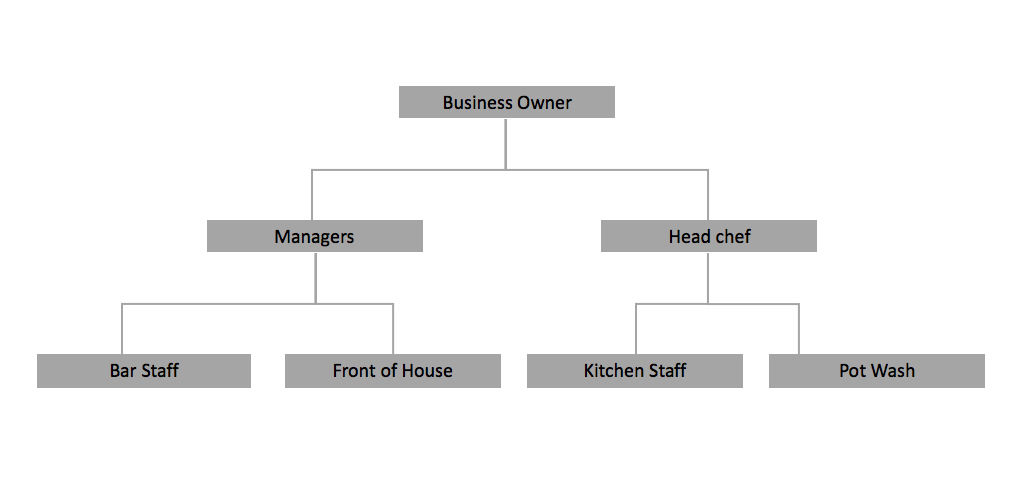
Appendix 2: The Three Levels of Strategy (Johnston, 2014)
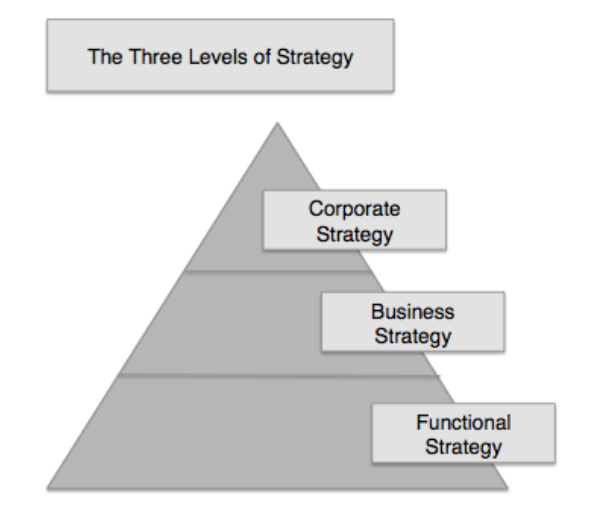
Appendix 3: The Three levels of Strategy within the Fleece’s organisational structure

Appendix 4: Henderson and Venkatraman’s Strategic Alignment Model for business (1989)
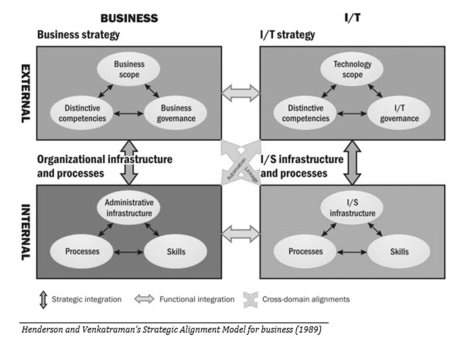
Appendix 5: The six alignment maturity criteria and their practices (Luftman, 2000)

Appendix 6: The five levels of the Strategic Maturity Model (Luftman, 2000)
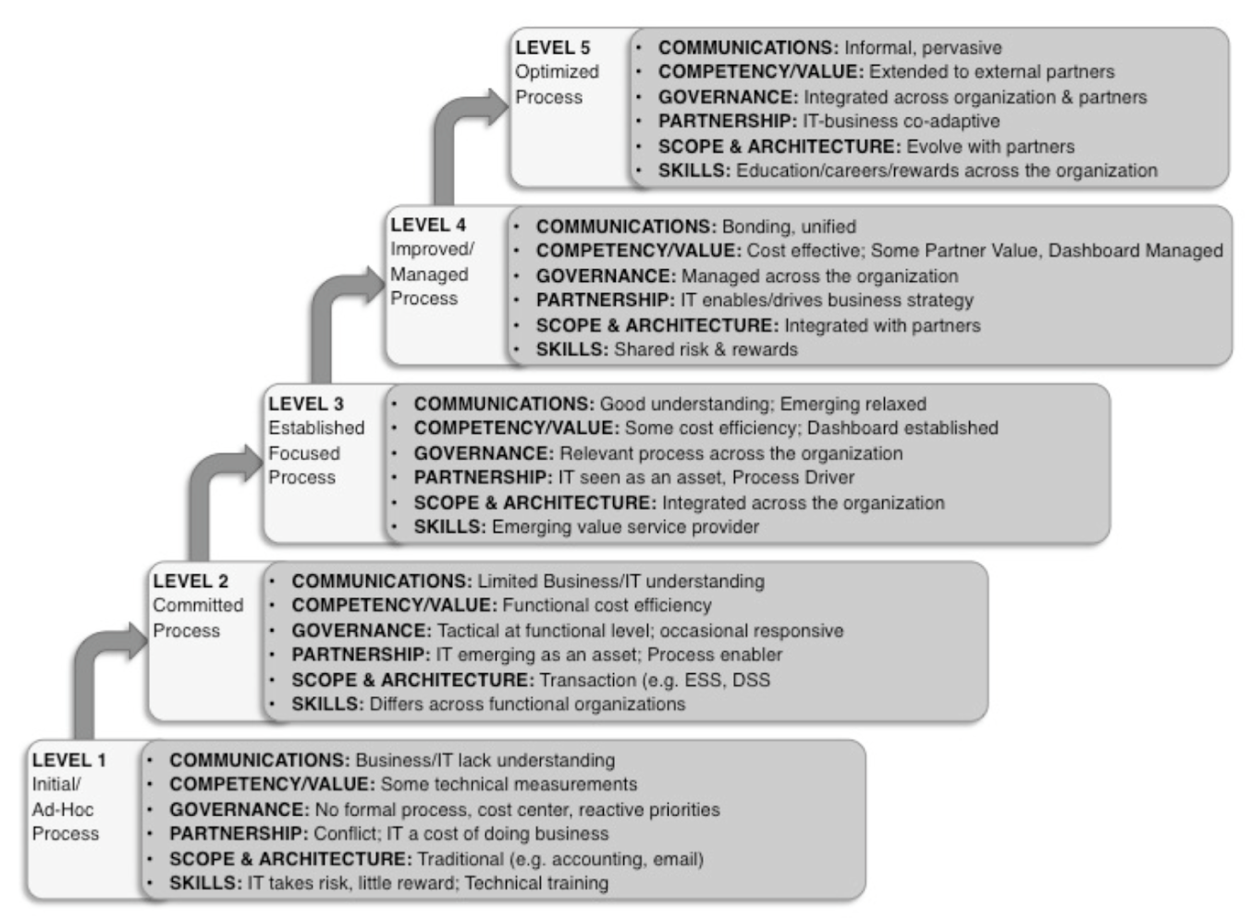
Appendix 7: The Business-IT Maturity Model by Vaughan Merlyn (Pearlson & Saunders, 2009)
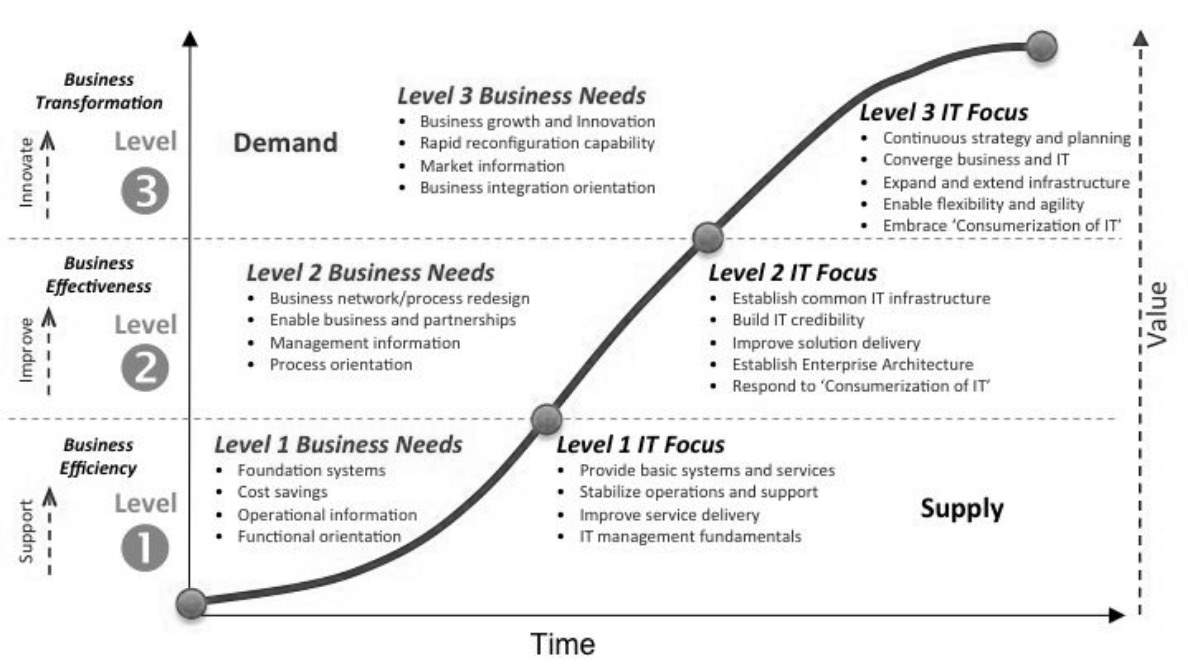
Appendix 8: Visualisation of theoretical concepts.
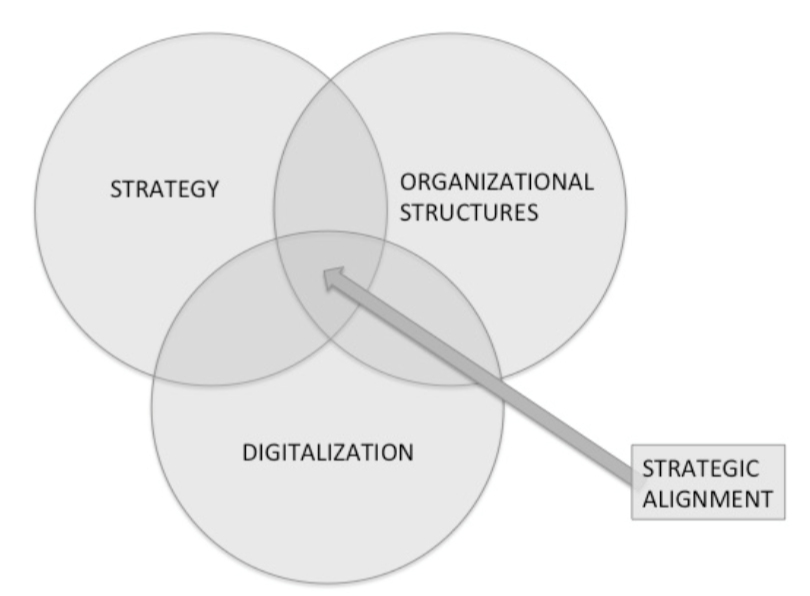
Appendix 9: Enablers and inhibitors of strategic alignment (Luftman, 2000)

Appendix 10: Strategy Execution Perspective (Venkatraman, et al., 1993)
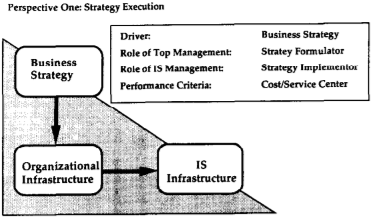
Appendix 11: Balance Scorecard
|
Perspective |
Objectives |
Measures |
Targets |
|
Financial |
Increase in business value and reputation |
Sales growth / positive reviews |
Increase sales 5% and positive reviews 10% |
|
Increased yearly profits |
ROI |
Annual revenue up 5% |
|
|
Internal Processes |
Improve customer communication methods in regards to table booking |
More effective table booking method / reduced complaints |
50% reduction in booking complaints |
|
Increase task efficiency |
Time taken to carry out tasks |
||
|
Stakeholders |
|||
|
To better understand customers and their patterns |
Increased collection of customer information / better reviews |
Begin colleting effective customer data |
|
|
To be regarded as the top restaurant venue in the local area |
Ratings on Google / Facebook compared to competitors |
More positive reviews on Facebook and Google |
|
|
Retain and attract customers |
Increase of new and returning customers |
10% increase in new customers and 5% increase in returning custom |
|
|
Innovation and learning |
Online booking functionality |
Increased number of bookings online |
80% reduction in booking complaints |
|
Use of business analytics and CRM to develop stronger relationships with customers and suppliers |
Increase in sales and B2C communication due to the use of these |
Increase communication B2C and B2B |
|
|
|
Increase task efficiency through use of internal automation |
Increase task efficiency |
Reduce time taken to complete key business tasks |
Cite This Work
To export a reference to this article please select a referencing stye below:
Related Services
View allDMCA / Removal Request
If you are the original writer of this essay and no longer wish to have your work published on UKEssays.com then please click the following link to email our support team:
Request essay removal


